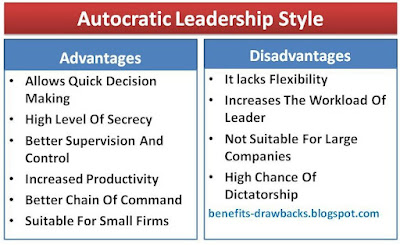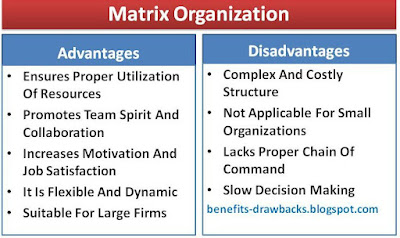What Is Laissez Faire Leadership Style ?
It is just opposite of authoritarian leadership style (where authority and power is exercised by the leader only). In laissez faire leadership style, authority is delegated to the employees and they are free to set goals and make decisions. Superiors trust their subordinates and do not interfere in their works. It encourages the employees to explore their knowledge , skills and capabilities in the organization.
Benefits Or Advantages Of Laissez Faire Leadership
The main advantages of laissez faire leadership style can be pointed out as follows:
1. Delegation Of Authority
One of the main benefits of laissez faire leadership is that authority and power is delegated to the members in the organization. Delegation of authority promotes specialization which helps to improve the performance and efficiency in the workplace.
2. Increased Motivation And Job Satisfaction
This leadership style provides opportunity for the subordinates to explore their skills and abilities. It also helps to increase creativity and develop decision making power. Therefore, employees are positively motivated which leads to increase in the job satisfaction.
3. Quick Decisions
As we know that subordinates have the authority to set their goals and make decisions to achieve those goals, it facilitates prompt decisions because they do not need to consult with their leaders to make any decision.
4. Proper Use Of Employees Potential
Another advantage of this leadership is that in ensures maximum utilization employees' potential in the workplace. Potentiality (skills, abilities, capabilities and creativity) of the subordinates are utilized properly which helps to obtain better output.
5. Development And Growth
Due to the limited role of the leader, subordinates have the opportunity to shine their skills, knowledge and performance. It is helpful in personal growth and career development.
6. Promotes Innovation
In this system, subordinates may find out shortcut methods and techniques to solve the problems. So, laissez faire leadership promotes innovations and new ideas in the organization.
7. Lower Employee Turnover
Because of positive motivation, possibility of growth and development, learning opportunity and better working environment, morale of the employees is increased. Increased morale and motivation decreases the rate of staff turnover.
The main disadvantages of laissez faire leadership can be pointed out as follows:
1. Not Suitable
This management system works properly if there are highly educated, skilled and specialist subordinates in the organization. It is not suitable for unskilled and inexperienced members because they cannot perform their tasks without proper guidance and supervision.
Also Read:
Advantages And Disadvantages Of Autocratic Leadership
Advantages And Disadvantages Of Democratic Leadership
2. It Lacks Privacy
All the internal matters of the organization are shared with the employees because of the openness of this leadership style. So, confidential matters may be leaked by the subordinates. Therefore, it is almost impossible to maintain secrecy and privacy.
3. Lacks Supervision And Control
Another notable disadvantages of laissez faire leadership is that it lacks proper supervision, monitoring and controlling because of the freedom given to the employees. Therefore, it is difficult to maintain discipline which may reduce the performance and the output.
4. Lack Of Accountability
Because of the lack of clearly defined roles and responsibilities of superiors and subordinates, it may create confusion and misunderstanding in the organization. It will be difficult for the top level management to decide whom to make responsible and accountable.
5. Weakens Leader's Role
Laissez faire leadership dilutes the role of leaders. Therefore, leaders cannot guide and instruct his/her subordinates properly. Also employee may ignore their superiors because of their weak position.
Pros And Cons Of Laissez Faire Leadership In Short
Pros:
- It encourages decentralization and specialization
- It increases the morale of the subordinates
- It facilitates personal growth and development opportunity
- It is very suitable for competent employees
- It encourages creativity and innovation
- It facilitates quick decisions
Cons:
- Because of the lack of secrecy, official matters may be leaked
- It dilutes the roles and importance of managers
- This system does not suits for unskilled, incompetent and inexperience subordinates
- There is a possibility of misunderstanding, confusion and conflict if the roles are not defined properly
- It lacks proper discipline in the workplace
- It lacks proper supervision and monitoring














